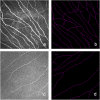Corneal nerve structure in patients with primary Sjögren's syndrome in China
- PMID: 33980205
- PMCID: PMC8117565
- DOI: 10.1186/s12886-021-01967-7
Corneal nerve structure in patients with primary Sjögren's syndrome in China
Abstract
Background: The aim of this study was to evaluate the in vivo confocal microscopic morphology of corneal subbasal nerves and its relationship with clinical parameters in patients with primary Sjögren's syndrome in China.
Methods: This was a case control study of 22 dry eye disease (DED) patients with primary Sjögren's syndrome (pSS) and 20 control subjects with non-Sjögren dry eye disease (NSDE). Each patient underwent an evaluation of ocular surface disease using the tear film break-up time (TBUT), noninvasive tear film break-up time (NIKBUT), noninvasive tear meniscus height (NIKTMH), corneal staining (National Eye Institute scale, NEI), Schirmer I test, meibography, and corneal subbasal nerve analysis with in vivo confocal microscopy (IVCM). The right eye of each subject was included in this study.
Results: SS patients showed a shorter TBUT (P = 0.009) and Schirmer I test results (P = 0.028) than the NSDE group. However, there was no significant difference in NIKBUT between the two groups (P = 0.393). The nerve density of subbasal nerves, number of nerves and tortuosity of the SS group were significantly lower than those of the NSDE group (P = 0.001, P < 0.001 and P = 0.039, respectively). In the SS group, the mean nerve length was correlated with age and the Schirmer I test (r = - 0.519, P = 0.013 and r = 0.463, P = 0.035, respectively). Corneal staining was correlated with nerve density and the number of nerves (r = - 0.534, P = 0.013 and r = - 0.487, P = 0.025, respectively).
Conclusions: Sjögren syndrome dry eye (SSDE) patients have more severe clinical dry eye parameters than non-Sjögren dry eye disease (NSDE) patients. Compared with NSDE patients, we found that SSDE patients showed decreased corneal subbasal nerve density and numbers.
Keywords: Corneal nerve; Dry eye disease; In vivo confocal microscopy (IVCM); Sjögren’s syndrome.
Conflict of interest statement
The authors declare that they have no competing interests.
Figures
Similar articles
-
Correlation between corneal innervation and inflammation evaluated with confocal microscopy and symptomatology in patients with dry eye syndromes: a preliminary study.Graefes Arch Clin Exp Ophthalmol. 2017 Sep;255(9):1771-1778. doi: 10.1007/s00417-017-3680-3. Epub 2017 May 20. Graefes Arch Clin Exp Ophthalmol. 2017. PMID: 28528377
-
Corneal nerve structure and function in patients with non-sjogren dry eye: clinical correlations.Invest Ophthalmol Vis Sci. 2013 Aug 1;54(8):5144-50. doi: 10.1167/iovs.13-12370. Invest Ophthalmol Vis Sci. 2013. PMID: 23833066
-
Analysis of the first tear film break-up point in Sjögren's syndrome and non-Sjögren's syndrome dry eye patients.BMC Ophthalmol. 2022 Jan 3;22(1):1. doi: 10.1186/s12886-021-02233-6. BMC Ophthalmol. 2022. PMID: 34980014 Free PMC article.
-
Tear cytokine levels in Sjogren's syndrome-related dry eye disease compared with non-Sjogren's syndrome-related dry eye disease patients: A meta-analysis.Medicine (Baltimore). 2024 Dec 6;103(49):e40669. doi: 10.1097/MD.0000000000040669. Medicine (Baltimore). 2024. PMID: 39654248 Free PMC article.
-
An Overview of the Dry Eye Disease in Sjögren's Syndrome Using Our Current Molecular Understanding.Int J Mol Sci. 2023 Jan 13;24(2):1580. doi: 10.3390/ijms24021580. Int J Mol Sci. 2023. PMID: 36675090 Free PMC article. Review.
Cited by
-
Segmentation and multiparametric evaluation of corneal whorl-like nerves for in vivo confocal microscopy images in dry eye disease.BMJ Open Ophthalmol. 2024 Oct 7;9(1):e001861. doi: 10.1136/bmjophth-2024-001861. BMJ Open Ophthalmol. 2024. PMID: 39375151 Free PMC article.
-
Trigeminal Nerve Affection in Patients with Neuro-Sjögren Detected by Corneal Confocal Microscopy.J Clin Med. 2022 Aug 1;11(15):4484. doi: 10.3390/jcm11154484. J Clin Med. 2022. PMID: 35956101 Free PMC article.
-
The Autoimmune Rheumatic Disease Related Dry Eye and Its Association with Retinopathy.Biomolecules. 2023 Apr 23;13(5):724. doi: 10.3390/biom13050724. Biomolecules. 2023. PMID: 37238594 Free PMC article. Review.
-
In Vivo Confocal Microscopy in Different Types of Dry Eye and Meibomian Gland Dysfunction.J Clin Med. 2022 Apr 22;11(9):2349. doi: 10.3390/jcm11092349. J Clin Med. 2022. PMID: 35566475 Free PMC article. Review.
-
CD4+ T cells drive corneal nerve damage but not epitheliopathy in an acute aqueous-deficient dry eye model.Proc Natl Acad Sci U S A. 2024 Nov 26;121(48):e2407648121. doi: 10.1073/pnas.2407648121. Epub 2024 Nov 19. Proc Natl Acad Sci U S A. 2024. PMID: 39560641 Free PMC article.
References
-
- Craig JP, Nelson JD, Azar DT, Belmonte C, Bron AJ, Chauhan SK, de Paiva CS, Gomes JAP, Hammitt KM, Jones L, Nichols JJ, Nichols KK, Novack GD, Stapleton FJ, Willcox MDP, Wolffsohn JS, Sullivan DA. TFOS DEWS II report executive summary. Ocul Surf. 2017;15(4):802–812. doi: 10.1016/j.jtos.2017.08.003. - DOI - PubMed
-
- Solomon A, Dursun D, Liu Z, Xie Y, Macri A, Pflugfelder SC. Pro- and anti-inflammatory forms of interleukin-1 in the tear fluid and conjunctiva of patients with dry-eye disease. Invest Ophthalmol Vis Sci. 2001;42(10):2283–2292. - PubMed
MeSH terms
Grants and funding
LinkOut - more resources
Full Text Sources
Other Literature Sources
Medical


